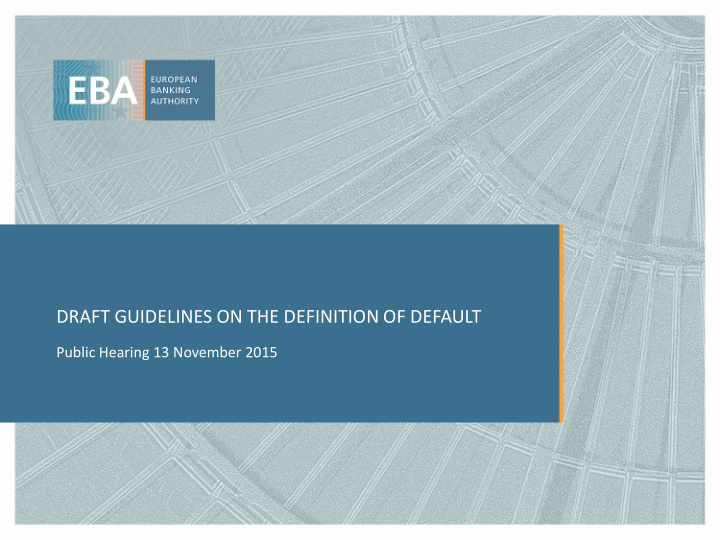



DRAFT GUIDELINES ON THE DEFINITION OF DEFAULT Public Hearing 13 November 2015
Guidelines on default definition – introduction This CP provides clarification on the application of Article 178 of the CRR as required by Article 178(7) of this Regulation. Consultation Paper on the Guidelines on the application of the definition of default (EBA/CP/2015/15) has been published on 22 September 2015 for 4 months consultation period. Comments to this consultation can be sent to the EBA by 22 January 2016. Simultaneously a QIS was launched to assess the likely impact of the most important policy options included in the draft Guidelines. Although it is expected that the Guidelines will have biggest impact on IRB firms they will also have an effect on the use of the Standardised Approach. Final Guidelines will take into consideration the results of the QIS and industry’s feedback received in the consultation period. Public hearing on the draft Guidelines on the definition of default 2
Background The Guidelines on the definition of default is part of the broader EBA work related to the review of the IRB Approach as described in the Discussion Paper on the Future of the IRB Approach (EBA/DP/2015/01) published in March 2015. The planned EBA work in this area is summarised in the table below: Prioritisation Regulatory products Current status Phase 1: Assessment RTS on IRB assessment methodology Finalisation stage methodology Phase 2: Definition of RTS on materiality threshold Consultation stage default GL on default of an obligor Phase 3: Risk parameters GL on PD estimation Preparation stage GL on LGD estimation GL on treatment of defaulted assets RTS on downturn conditions Phase 4: Credit risk RTS on conditional guarantees Planning stage mitigation RTS on liquid assets RTS on master netting agreements Public hearing on the draft Guidelines on the definition of default 3
Guidelines on default definition – main policy options Consistency with the RTS on materiality threshold Days past due Definition of technical default – errors in data, IT systems and processes or lengthy payment allocation criterion processes Specific credit risk adjustments All SCRA except IBNR indicate default • IFRS 9 – exposures classified as ‘Stage 3’ • Sale of credit obligations – default when economic loss is related with credit quality and the loss is material i.e. higher Indications of than specified threshold unlikeliness to pay Distressed restructuring Definition based on forbearance • Loss based on comparison of discounted cash flows • Other indications of unlikeliness to pay Should reflect characteristics of different types of exposures • Should include the treatment of connected clients • Public hearing on the draft Guidelines on the definition of default 4
Guidelines on default definition – main policy options Only for IRB Approach Default definition Broad equivalence with the internal definition of default in external data Where necessary – additional margin of conservatism Minimum probation periods for days past due criterion: Starting when indications of default cease to apply • At least 3 months • Minimum probation periods for distressed restructuring Criteria to return Starting from the latter of: (i) restructuring contract, • to non-defaulted (ii) default identification, (iii) end of grace period status At least 1 year • Material payment made by the obligor during the probation • period Monitoring policies to avoid excessive number of multiple defaults Public hearing on the draft Guidelines on the definition of default 5
Guidelines on default definition – main policy options Possibility to use different default definitions for Consistency of different types of exposures where justified Consistent identification of default of a single obligor default definition within an institution and the group Consistent level of application of default definition across the group, unless there are no or very few Retail exposures common clients Default contagion rules for joint credit obligations Documentation requirements including a register of default definitions Governance Additional requirements for IRB firms regarding internal governance, use test and internal audit Public hearing on the draft Guidelines on the definition of default 6
EUROPEAN BANKING AUTHORITY Floor 46, One Canada Square, London E14 5AA Tel: +44 207 382 1776 Fax: +44 207 382 1771 E-mail: info@eba.europa.eu http://www.eba.europa.eu
Recommend
More recommend